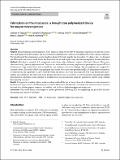Files in this item
Fabrication on the microscale : a two-photon polymerized device for oocyte microinjection
Item metadata
| dc.contributor.author | Yagoub, Suliman H. | |
| dc.contributor.author | Thompson, Jeremy G. | |
| dc.contributor.author | Orth, Antony | |
| dc.contributor.author | Dholakia, Kishan | |
| dc.contributor.author | Gibson, Brant C. | |
| dc.contributor.author | Dunning, Kylie R. | |
| dc.date.accessioned | 2022-05-19T11:30:14Z | |
| dc.date.available | 2022-05-19T11:30:14Z | |
| dc.date.issued | 2022-05-12 | |
| dc.identifier | 279613886 | |
| dc.identifier | 51899acd-58dd-4ba2-a8fa-98859b157d8b | |
| dc.identifier | 85129840288 | |
| dc.identifier | 000794072900002 | |
| dc.identifier.citation | Yagoub , S H , Thompson , J G , Orth , A , Dholakia , K , Gibson , B C & Dunning , K R 2022 , ' Fabrication on the microscale : a two-photon polymerized device for oocyte microinjection ' , Journal of Assisted Reproduction and Genetics , vol. First Online . https://doi.org/10.1007/s10815-022-02485-1 | en |
| dc.identifier.issn | 1573-7330 | |
| dc.identifier.other | RIS: urn:4DF8EC603EF642324C3D1379B12CF82B | |
| dc.identifier.other | RIS: Yagoub2022 | |
| dc.identifier.uri | https://hdl.handle.net/10023/25408 | |
| dc.description | Open Access funding enabled and organized by CAUL and its Member Institutions. KRD is supported by a Mid-Career Fellowship from the Hospital Research Foundation (C-MCF-58–2019). KD acknowledges funding from the UK Engineering and Physical Sciences Research Council (grant EP/P030017/1). This study was funded by the Australian Research Council (ARC) Centre of Excellence for Nanoscale BioPhotonics (CE140100003). | en |
| dc.description.abstract | Purpose Intracytoplasmic sperm injection (ICSI) addresses male sub-fertility by injecting a spermatozoon into the oocyte. This challenging procedure requires the use of dual micromanipulators, with success influenced by inter-operator expertise. We hypothesized that minimizing oocyte handling during ICSI will simplify the procedure. To address this, we designed and fabricated a micrometer scale device that houses the oocyte and requires only one micromanipulator for microinjection. Methods The device consisted of 2 components, each of sub-cubic millimeter volume: a Pod and a Garage. These were fabricated using 2-photon polymerization. Toxicity was evaluated by culturing single-mouse presumptive zygotes (PZs) to the blastocyst stage within a Pod, with several Pods (and embryos) docked in a Garage. The development was compared to standard culture. The level of DNA damage/repair in resultant blastocysts was quantified (γH2A.X immunohistochemistry). To demonstrate the capability to carry out ICSI within the device, PZs were microinjected with 4-μm fluorescent microspheres and cultured to the blastocyst stage. Finally, the device was assessed for oocyte traceability and high-throughput microinjection capabilities and compared to standard microinjection practice using key parameters (pipette setup, holding then injecting oocytes). Results Compared to standard culture, embryo culture within Pods and a Garage showed no differences in development to the blastocyst stage or levels of DNA damage in resultant blastocysts. Furthermore, microinjection within our device removes the need for a holding pipette, improves traceability, and facilitates high-throughput microinjection. Conclusion This novel device could improve embryo production following ICSI by simplifying the procedure and thus decreasing inter-operator variability. | |
| dc.format.extent | 11 | |
| dc.format.extent | 1381547 | |
| dc.language.iso | eng | |
| dc.relation.ispartof | Journal of Assisted Reproduction and Genetics | en |
| dc.subject | ICIS | en |
| dc.subject | IVF | en |
| dc.subject | Infertility | en |
| dc.subject | ART | en |
| dc.subject | 3D fabrication | en |
| dc.subject | High-throughput microinjection | en |
| dc.subject | QC Physics | en |
| dc.subject | QH301 Biology | en |
| dc.subject | NDAS | en |
| dc.subject.lcc | QC | en |
| dc.subject.lcc | QH301 | en |
| dc.title | Fabrication on the microscale : a two-photon polymerized device for oocyte microinjection | en |
| dc.type | Journal article | en |
| dc.contributor.sponsor | EPSRC | en |
| dc.contributor.institution | University of St Andrews. School of Physics and Astronomy | en |
| dc.contributor.institution | University of St Andrews. Sir James Mackenzie Institute for Early Diagnosis | en |
| dc.contributor.institution | University of St Andrews. Centre for Biophotonics | en |
| dc.contributor.institution | University of St Andrews. Institute of Behavioural and Neural Sciences | en |
| dc.contributor.institution | University of St Andrews. Biomedical Sciences Research Complex | en |
| dc.identifier.doi | https://doi.org/10.1007/s10815-022-02485-1 | |
| dc.description.status | Peer reviewed | en |
| dc.identifier.grantnumber | EP/P030017/1 | en |
This item appears in the following Collection(s)
Items in the St Andrews Research Repository are protected by copyright, with all rights reserved, unless otherwise indicated.

